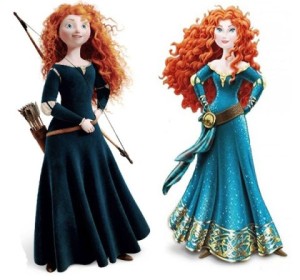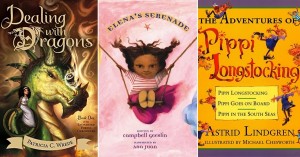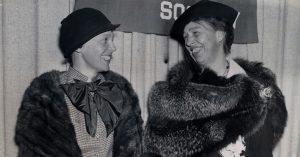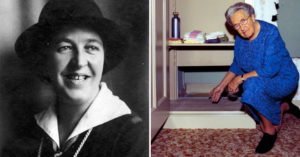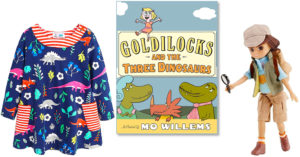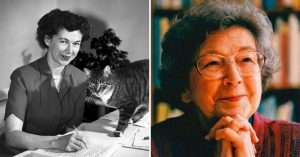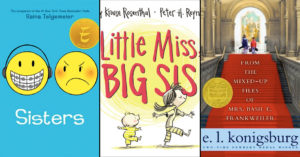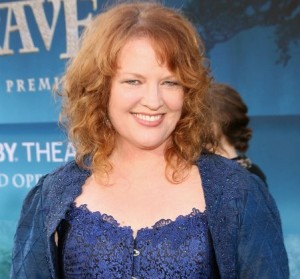 Brenda Chapman at the "Brave" premiere in Los Angeles. Image Source: Getty
Brenda Chapman at the "Brave" premiere in Los Angeles. Image Source: GettyOscar-winning Brave writer and director Brenda Chapman, a supporter of A Mighty Girl’s “Keep Merida Brave” petition campaign, granted us her first in-depth interview discussing the Merida makeover. In this Q&A interview with A Mighty Girl co-founder Carolyn Danckaert, Chapman shares her views on the redesign of the character she created and its broader significance.
Danckaert: Before we discuss the makeover, can you tell me in your view what was so special about Merida as a character and how did her original visual depiction speak to that uniqueness?
Chapman: I let Merida's personality guide me as far as her wild hair. I wanted it to visually depict her attitude, her emotional make up so it wasn't just about “Oh look, she has cool red hair.” I wanted to make a statement with it as opposed to suggesting that she’s just trying to look pretty -- which she’s not. That’s just her natural wild, curly hair.
And as far as her body, I wanted to show a regular teenage girl’s body not one that of a girl trying to use push-up bra and go on a major diet or anything. I wanted her to look normal, like how girls look in real life.
My daughter was only five years old when we started designing Merida, but I wanted her to personality-wise embody my daughter so that she would have a role model. And it’s really funny because Merida's body type really is my daughter’s right now. I just wanted a character that girls could relate to and not feel inadequate when they watched her.
Danckaert: Along those lines, there was a fantastic quote in the San Francisco Chronicle from a dad whose 3-year-old son absolutely loved Merida and how for him it wasn't because she was a princess but because Merida was his first real movie hero. She sends such an important messages not only to girls but also to boys too that girls can also be heroic, courageous, and adventurous. Was this one of your intentions when you created Merida?
Chapman: Absolutely! I think it's wonderful that a little boy looks at Merida as a hero. Finally! That is so vindicating for me! And it's just fantastic for both girls and boys that that can actually happen.
I’d also add that I don’t like the word “tomboy” because I don’t like strong girls being called a boy. It’s just my own little hangup -- that’s a girl. That’s a real girl. And that’s the other thing that I told people on the film: Merida is not a tomboy. She’s a girl who’s just fine being a girl. I don’t want her being put in pants. That’s what they wore at that time so let her be in the dress, let her be comfortable, let her have figured out how to maneuver in it and it’s not like she hates being a girl. That’s the other side of the coin that I wanted to present as well.
Danckaert: Now, getting to the makeover, how did you learn about the redesign and what was your first reaction to it?
Chapman: Well, actually I first learned about it through A Mighty Girl -- from your comparison image of the two Meridas and the petition. Someone sent that to me because I was out of the country travelling. I was stunned when I saw it, but I wasn't surprised. I was still just shocked because they never cease to amaze me on how low they go with these images intended for young girls. I was very disappointed because I was hoping that Pixar would try a little harder to protect her since she was a Pixar princess, but I guess even they got outvoted if they even tried.
Danckaert: I've heard from some people who say they don’t really see the redesign. They claim that the images look more or less the same to them. As Merida’s creator, how would you describe the differences between the two Meridas?
Chapman: Number one, just to be a little snide: get some glasses. Secondly, look a little closer. It’s kind of a subliminal thing if some adults are looking at it going “What’s the big deal?” saying, “She’s got a long dress and big red hair.”
But if you need to look closer, look at the attitude. Look at how she’s posed. Look at how much tinier her waist is and how much bigger her boobs are. Look at the off the shoulder dress. It’s just that they have sexed her up. And you can look at the childlike proportions of the real Merida’s face and her body and see that she’s not fully a woman yet, but she’s not a straight-waisted little girl either. You can’t escape the hourglass voluptuousness of this redesigned version.
Yes, it’s a drawing, but I can make a drawing of the real Merida that looks like the real Merida and I know the artists that they have make these drawings could do the same; they've just been directed not to.
Danckaert: This ties into another critique that I’ve heard. There are people who argue that this is just a transition from a 3D to a 2D image -- that there’s naturally going to be some changes during that process and this redesigned version just displays those changes.
Chapman: No, that is totally wrong. As an artist I know how to draw Merida and it’s not just because I created her. I didn’t do the physical designing of her, though I directed it. But I could, even as a rough sketch. I could draw that character without having to make her have bigger boobs and a smaller waist and a sexy come-hither look on her face and look about 15 years older. I can make her look like the 15, 16 year-old Merida that she is.
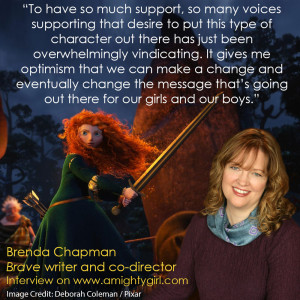 Danckaert: Given these differences, let’s discuss the core issue -- so they've made her more mature and sexed her up, why do these changes matter?
Danckaert: Given these differences, let’s discuss the core issue -- so they've made her more mature and sexed her up, why do these changes matter?
Chapman: Well, partly it matters because Merida was created specifically to break that mold. She was created to turn the regular Disney princess on its head. To show that Merida is closer to a real princess than those princesses. Princesses were working girls and so were their mothers and so I gave her a modern twist.
I wanted to create a stronger character, one that feels and looks attainable, that’s not waiting for the prince or the man to come along or needs romance to make them complete. I also left it open so that romance wasn’t completely cut out of the picture when she’s ready and of her own choosing as opposed to her being forced into something that she didn't choose. I wanted to give her that strength.
Danckaert: We've had some people respond to our petition who say, “it’s just a cartoon -- what’s the big deal?” On A Mighty Girl, we feature the world’s largest collection of girl-empowering books and other media so I certainly appreciate the power of story as a source of cultural messages and values. As an animator and director, how would you describe the power of image in this respect?
Chapman: Kids relate to cartoons and they take them in and, no, it’s not a photograph or a real person but photographs have only been around for about 100 years. Before that it was paintings and drawings that were the images that people took in. Even back in the day when they were doing fashion design they made these little tiny, tiny waists and that’s why the corset came in and you tried to get the tiny waists and women were fainting all the time.
Imagery is an incredibly powerful subconscious message to children and to people in general. Children love cartoons so they’re gonna soak that in. And yes, parents should be guiding their children and teaching them the right things, and, yes, parents should be the people they listen to.
But parents aren't superhuman and unless you’re locking your kid in a closet you’re not going to be able to protect them from all this imagery that’s out there -- we’re just inundated with it. Merida is an incredibly popular character right now and to change her, even though she’s a cartoon, still has a very huge effect on how little girls think about themselves and their self images.
Danckaert: You've stated that previously that one of your goals with Merida was to “break that mold.” Can you speak further on what exactly the status quo is and what is the value of an initiative like this from a more systemic perspective?
Chapman: The status quo seems to be that you have to be stick thin, perfect skin, perfect hair, perfect clothes and basically eye candy for males and that’s just such a disservice to our little girls and to ourselves. The problem is all the images we see are now manipulated, even the perfect supermodels aren't perfect supermodels. All their blemishes are taken away, their breasts are slightly enlarged, their hips are slightly toned down or curved toward where they need to be. You can’t trust anything you see in a magazine, on film, anywhere to be realistic.
I think imagery is a huge, powerful thing and that’s why so many women have eating disorders and such low self-esteem or don’t try to push themselves to be what their potential can be because they are focused on their image.
It’s just putting us in this really bad place and keeping women sort of in this box that we need to get out of. I think it’s also affecting men who end up thinking "Yeah, that’s the way it is. What’s wrong with that? Sex her up -- she looks better!" It’s like, really, your mom taught you that was OK? Really, it’s disturbing.
Danckaert: The other critique that we've seen expressed is if you don’t like the new Merida, just don’t buy the merchandise. And, that’s such a common response to these types of initiatives, anytime you critique a character or a toy, for example, you hear, "if you don’t like it, don’t buy it." I was wondering how you’d respond to this argument especially since a character like Merida has such larger symbolic value.
Chapman: On one hand, I agree don’t buy it, because that will send a message too. But I think this goes beyond that because there will be people who buy it because "Oh, it’s Disney. Oh, it’s that princess." There are people who aren't paying attention, people who aren't thinking about these issues so I think it’s our responsibility to bring it up. That's one reason I created Merida, to help people recognize some of the differences between a character like her and those coming out of the princess mold.
Those people that have recognized that there’s a problem with this makeover appreciate what Merida is so I feel like she’s worth fighting for and saying, "No, look, make the toys who the character is." So definitely, don’t buy this new Merida but see if we can get them to change so they’ll make Meridas that we’ll want to buy.
I got into a little back and forth with someone at the Huffington Post who said "Get over yourself. It’s a cartoon." I realized that they just wanted to be argumentative about it but some people have this idea that anybody who’s worried about the design of a cartoon needs to get over themselves. And, maybe it’s not an issue that you care about it but I care about it and a lot of other people do too. So let us have that without feeling like you need to insult us, but if you feel you do, more power to you, I’m still carrying on; I’m not going to be intimidated by your low opinion of me to be quiet about what I feel strongly about.
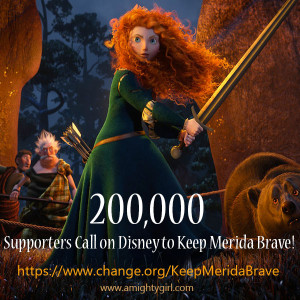 Danckaert: What would you like to see Disney do at this point?
Danckaert: What would you like to see Disney do at this point?
Chapman: I would love to see Disney pull all of those changed images of Merida worldwide, and have her drawn to represent the character she is in the movie. In fact - there are plenty of drawings at Pixar that do just that - the ones we built her character in the computer. She was drawn first, then built.
Danckaert: Finally, what message would you like to send to all those who have signed the petition and supported the “Keep Merida Brave” campaign?
Chapman: I’d just like to say thank you from the bottom of my heart. I've had my issues with being able to finish the movie and all of that and have been so relieved that the Merida that I created is still the Merida in the film. Then to watch this happen, to have so much support, so many voices supporting that desire to put this type of character out there has just been overwhelmingly vindicating.
It gives me optimism that we can make a change and eventually change the message that’s going out there for our girls... and our boys. I keep saying little girls, but it’s for little boys too because they’ll learn a respect and a different view of women if we can keep pushing to make things better for everyone.
Mainly, just thank you. I’m just overwhelmed with gratitude for it.
Brenda Chapman is a writer, animation story artist and director who wrote and co-directed Brave and recently won an Academy Award for Best Animated Feature for the film. She was also the first woman to direct an animated feature from a major studio, DreamWorks Animation's The Prince of Egypt.
Carolyn Danckaert is the co-founder of A Mighty Girl, a girl empowerment website with the world’s largest collection of nearly 5,000 girl-empowering books, toys, movies, clothing and music for parents, teachers, and others dedicated to raising smart, confident, and courageous girls.









